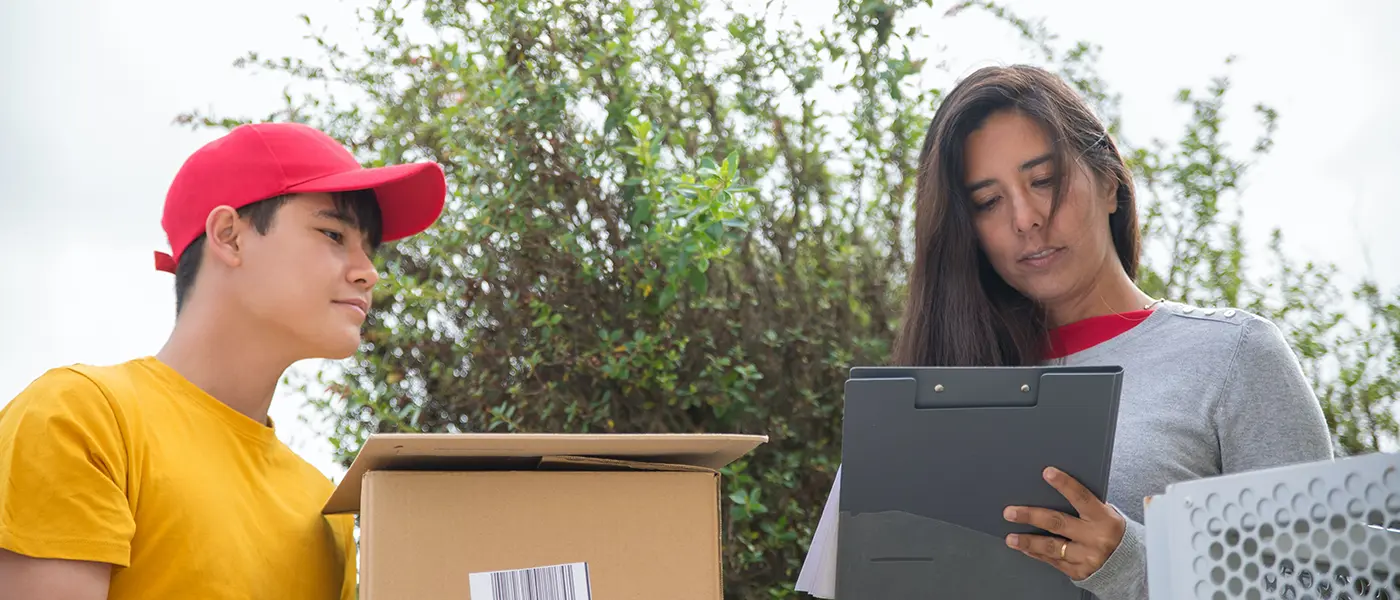What is a Return Label?
A return label is a prepaid shipping label that contains information such as a business address, a shipping barcode, or any other detail required to return a package. NRF cites that customers returned US$428 billion worth of merchandise in 2020. Hence, return labels hold utmost importance in the returning process.
A return label can be treated as a regular shipping label. In other words, you can also use every bit of information required to create an ideal shipping label for a good return label. The product’s origin or the seller’s warehouse address becomes the destination in a return label.
There might be several reasons for the occurrence of an unprofitable event like return. Some common ones are damaged goods during shipping and handling, the disparity between image and product, or unreasonable customer behavior. Even with such reasons at play, the outcome is clear. A plan to reinforce such an outcome with intent can often save money and improve customer satisfaction.
What Are Prepaid Return Labels?
A prepaid return label is a label where the seller has already paid shipping charges for the product’s return.
The shipping return label might be redundant for companies with dedicated shipping and logistics services. However, a prepaid return label is crucial for e-commerce companies that rely on dedicated shipping support. Package returns form an inherent part of the e-commerce industry, and sellers should always plan such returns.
Without a prepaid return label, a seller will need to re-arrange the whole transit and put it to work. As a seller is responsible for carrying out or managing all the aspects of a business, prepaid return labels are an excellent way to save time and effort. Such a plan always works in favor of the seller as it ideally automates the process in case an event of return arises.
How do they work?
A prepaid return label removes the requirement of re-arranging the shipping from the seller’s end. This is because a product return has already been planned. In such cases, the customer must raise a ticket and return the product to the courier. After the courier receives the product, the shipping cycle is repeated with the seller’s business address as the destination. However, for more clarity, the series of steps are listed below.
- Initiation: Customers can raise a ticket if they want to return a product. Based on the ticket, a seller can either accept or reject the request. If a seller agrees with the return ticket, they need to initiate the return process, which has already been paid for beforehand.
- First-mile delivery: The courier receives the product from the customer and takes it back to the nearest hub.
- Middle-mile delivery: As the product arrives at the warehouse, it is processed as per the destination of the following seller’s nearby warehouse. Once this process is completed, the product is sent as per the selected mail class.
- Last-mile delivery: Once the product reaches the nearest warehouse, it is sorted and sent out through a courier. As per the given address, the seller receives the returned product. As last-mile delivery encompasses 53% of the shipping cost, Insider Intelligence, a seller can negate this part of the process by receiving the product at the nearest hub.
Steps to Creating a Return Label
Creating a shipping return label might sound like a trivial affair, but sellers who ship out several products daily have a different opinion. A business is only scalable when every aspect, big or small, is scalable. Manual work has been a roadblock to scalability, and the creation of manual return labels is no exception to this idea. Here’s what needs to be done to create a long-lasting scalable process for creating a return label in the current industry.
Step 1: Choose a shipping carrier and mail class
To create a unique return label, a seller must select a shipping carrier and a mail class. One should complete this step with two things in mind: cost and quality.
Sellers often select the lowest mailing class for a returned product. Irrational consumer behavior is a significant cause of product return. Therefore, a seller should always consider the mail class’s quality and cost.
Step 2: Enter the address
The seller must enter the address where they want to receive the returned products. It is a one-time action unless the seller wants to receive the products elsewhere. In that case, the seller can change the address again.
Step 3: Pay for postage
It ideally points to the creation of a prepaid shipping return label. It is a systematic process in every order, where the seller must pay the postage for the return in case such an incident were to happen. Most shipping companies forward the paid return postage charges to other products and adjust them accordingly.
How E-commerce Businesses Can Provide Return Labels
As an e-commerce brand, two ways can be used to provide return labels. While one is deemed convenient for both the brand and the customer, the other includes some hassles. The two methods are listed below.
Including the label in the shipped package
An e-commerce brand can attach a return label to the product before it is shipped. One must know that a return label differs from a package slip. Usually, package slips include details of the items included in the package. Whereas, return labels primarily include details on returning address.
In case of a return, the customer must hand the product back to the courier, and the seller receives it without further effort.
Letting customers print their label
In this process, no return label is attached beforehand. Once a customer raises a ticket, the e-commerce brand mails the return label to the customer. In such a case, the customer needs to print and attach the return label on their own before handing it over to the courier. Once the courier receives the product, the rest of the process follows.
As one can understand, this process requires the customer’s and brand’s effort. While the brand creates and mails the return label, the customer must print and attach it to the product.
Why Should Your E-commerce Businesses Include Return Labels in Packages?
1. Saves your customers time and effort
The most significant upside of including a return label on a product is that the customer is only required to hand it back to the courier. There is no hassle of going back and forth with the company, printing the label, and pasting it. Such a process can further upset the already unhappy customer who has opted to return the product. Therefore, this process of providing and using a return label is often used by e-commerce brands.
2. You can select the lowest-cost mail option
A prepaid return label allows the seller to prepare in advance in case of uncertainty. In most cases, such a situation is negated, but risk management has always been crucial to business growth. There is no doubt that a return is costly, yet it is an obstacle to brand growth.
While creating a return label, a seller can always opt for the lowest-priced mail option to save some shipping cash. Even though selecting such an option is not always recommended, the mentioned mailing class has significantly evolved regarding quality handling.
3. Ensures the package is returned properly
Providing a return to the customer and paying for the to-and-fro shipping is already a considerable expenditure. However, letting a customer handle the addition of a return address might also result in a complete loss of the product. Inherently customers are not used to such a process, and expecting a successful execution might sound unfair. Therefore, adding a return label before, and dismissing the requirement of an unhappy customer to do so, is the safest option.
4. Return labels cost nothing unless they’re used
Product returns are inherent in the e-commerce ecosystem, but not every product is returned. On the contrary, sellers must go through only a few such cases. Adding a return label to the product does not cost anything unless used. A return label is just a precautionary step to deal with the worst.
Conclusion
Returns are the necessary evils in a business that every seller might come across. A seller can control several reasons for returns, but irrational customer behavior is a significant cause. Returns are costly, but uncertainty makes them more challenging to handle. Prepaid return labels have always saved the seller from such a situation. Such tags are only used when required, but consistently placing a solution like a return label beforehand exhibits a brand’s expertise and thoughtfulness at all levels.
FAQs
How do I create a prepaid return label?
You can create a return label by simply adding the address where you want to receive the product in case of a return. To make it more convenient, you can get in touch with your shipping company and acquire a shipping barcode for your location. Adding a shipping barcode makes things more convenient and results in faster transit.
Do I put the return label over the original label?
It is not recommended to put a return label over an original label. One can attach the return label somewhere alongside the original label.
Do I tape the return label on the box?
Yes, you can tape the return label on the box. However, one must ensure that the tape or the return label stays intact and attached to the box. Using good-quality tape or adhesive is highly recommended.
Where to put the return label on the package?
You can stick the return label anywhere on the product. Attaching the same close to the shipping label is the best practice.
How to create a return label for QR codes?
To make a return label for QR codes, you must contact your shipping company. Shipping companies generate QR codes based on the destination address of the seller. Once such a QR code is generated, it can be included and attached to every product that leaves the warehouse.
How do I make my return address labels?
You can make a return label by adding your address to a blank label. You can order return labels from sites like eBay and more. To take things further, you can also get in touch with your shipping company and get a QR generated for the destination address. Now, you can also attach the QR code to your return label.
Will the post office print a shipping label from my phone?
A few post offices will help you print a shipping label from your phone. However, this depends on one office to another.
How do I schedule a pickup or find a location for return shipments?
A third-party shipping company automates this process. Usually, the pickup and the location are decided based on the mutual convenience of both parties. Connecting with your shipping service provider is the best answer to this question.
Does the original online store or shipper need to coordinate pickups for returns?
Coordination is necessary for every aspect of a return. The online store needs to provide the correct return address and be available during the time of decided pickup.




